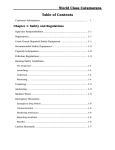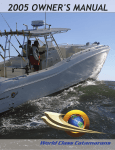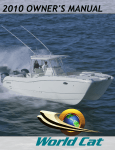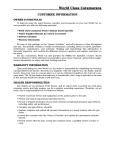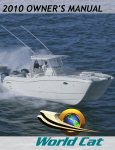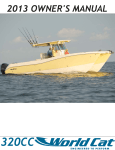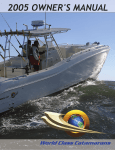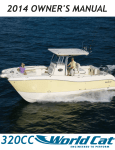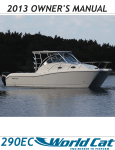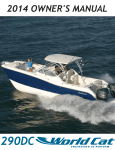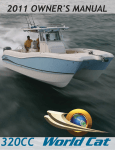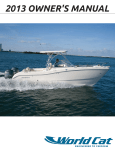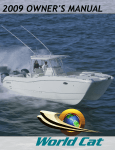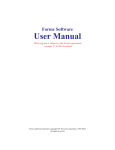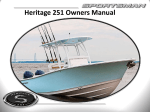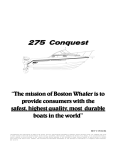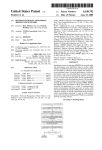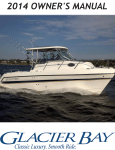Download World Class Catamarans 2004 World Class 270SD Owner`s manual
Transcript
2005 OWNER'S MANUAL World Class Catamarans Table of Contents Customer Information ................................................................. I Chapter 1: Safety and Regulations Operator Responsibilities ............................................................. 1-1 Registration ................................................................................. 1-1 Coast Guard Required Safety Equipment ..................................... 1-1 Recommended Safety Equipment ................................................. 1-2 Capacity Information ................................................................... 1-2 Pollution Regulations................................................................... 1-3 Oil and Hazardous Substances..................................................1-3 Disposal of Plastics/Dunnage/Garbage .....................................1-3 Boating Safety Guidelines ............................................................ 1-4 Pre-Departure ...........................................................................1-4 Launching.................................................................................1-4 Underway..................................................................................1-4 Returning .................................................................................1-4 Trailering..................................................................................... 1-5 Anchoring.................................................................................... 1-5 Shallow Water.............................................................................. 1-5 Emergency Situations .................................................................. 1-6 Emergency Stop Switch.............................................................1-6 Communication ........................................................................1-6 Rendering Assistance ................................................................1-6 Reporting Accidents ..................................................................1-6 Weather ....................................................................................1-6 Towing ......................................................................................1-6 Carbon Monoxide ........................................................................ 1-7 World Class Catamarans Chapter 2: Performance Overview...................................................................................... 2-1 Motor Trim Bow Up Condition .....................................................................2-1 Bow Down Condition.................................................................2-1 Engine Controls........................................................................... 2-2 Steering Controls......................................................................... 2-2 Steering Maintenance .................................................................. 2-2 Steering System Diagram............................................................. 2-3 Steering System Bleeding Instructions ......................................... 2-4 Handling Characteristics ............................................................. 2-5 Turning Characteristics ............................................................2-5 Adverse Sea Conditions .............................................................2-5 Boating Tips ................................................................................ 2-6 Performance Factors.................................................................... 2-6 Engine Efficiency ......................................................................2-6 Propeller Condition ...................................................................2-6 Weather Conditions ...................................................................2-6 Load..........................................................................................2-7 Marine Growth ..........................................................................2-7 Bottom Paint .............................................................................2-7 World Class Catamarans Chapter 3: Systems Information Overview...................................................................................... 3-1 Fueling Guidelines Before Fueling...........................................................................3-1 During Fueling ..........................................................................3-1 After Fueling .............................................................................3-1 Fuel System................................................................................. 3-2 Fuel System Diagram................................................................... 3-2 Electrical System ......................................................................... 3-3 Battery System ............................................................................ 3-3 Battery Distribution ..................................................................3-3 Voltage Sensor Relay .................................................................3-4 Emergency Parallel....................................................................3-4 24 Hour Circuits .......................................................................3-4 Anchor Windlass .......................................................................3-4 Battery Selection ......................................................................... 3-4 Battery Care ................................................................................ 3-5 Wiring and Circuit Protection....................................................... 3-6 Digital Control System ................................................................. 3-6 Typical Digital Control Diagram ................................................... 3-7 Accessories .................................................................................. 3-8 Gauge Packages........................................................................... 3-10 Yamaha™..................................................................................3-10 Honda™....................................................................................3-10 Suzuki™ ...................................................................................3-10 Plumbing Systems ....................................................................... 3-10 World Class Catamarans Chapter 4: Maintenance and Service Overview...................................................................................... 4-1 Gelcoat Maintenance ................................................................... 4-1 Cleaning ...................................................................................4-1 Waxing ......................................................................................4-1 Repair .......................................................................................4-2 Bottom Paint ............................................................................... 4-2 Upholstery................................................................................... 4-3 Trim/Plexiglass/Polyethylene ...................................................... 4-3 Stainless/Aluminum ................................................................... 4-3 Bilge Compartments .................................................................... 4-3 Cockpit Drains ............................................................................ 4-3 Winterization ............................................................................... 4-4 Chapter 5: Model Specific Table of Contents......................................................................... 5-1 Model Specific information for your boat Warranty Information World Class Catamarans CUSTOMER INFORMATION OWNER’S PORTFOLIO To help you enjoy the many features, benefits, and accessories on your new World Cat, we have provided you with the following materials: • World Class Catamaran Owner’s Manual (model specific) • Vendor Supplied Manuals for various accessories • Delivery Checklist • Warranty Information We refer to this package as the “Owner’s Portfolio”, and will reference it often throughout this text. The portfolio contains a wealth of information, including advice on safety, operation, performance, maintenance, and warranty. Reading and maintaining this information is extremely important, and could be the difference between a positive and negative experience on the water. For you convenience, World Cat also provides the NMMA text Sportfish, Cruisers, Yachts Owner’s Manual. It will be referenced occasionally in your owner’s manual, and provides supplemental information on safety and basic boating practices. WARRANTY INFORMATION Upon purchasing your new World Cat, the dealer is responsible for completing the warranty card provided by the factory. The form is in triplicate, with one copy for you, the dealer, and the factory. Keep your copy in a secure place so it can be referenced quickly in the event of a warranty issue. The 10 year limited hull warranty is transferable, and a copy is included at the back of this manual should you decide to sell your boat. DEALER RESPONSIBILITIES Our dealers are an extension of the factory, and we expect them to provide you with great customer service and help prepare you for a positive ownership experience. Therefore, we set forth a list of responsibilities for our dealers as follows: • Provide courteous service and explanation of the product prior to the sale. • Provide sea trials, if requested, for potential owners. • Provide a detailed orientation of your boat’s features and general operation upon delivery, including safety and performance. • Complete and sign delivery checklist. • Explain, complete, and submit all warranty information in a timely manner after the purchase. • Provide the customer with the “Owner’s Portfolio” and explain the information included therein. • Provide service after the sale, or help the customer locate a qualified service at home or away. World Class Catamarans OWNER’S RESPONSIBILITIES As A Consumer you should also take an active part in the delivery and safe operation of your new catamaran. Some of your responsibilities are: • Study and understand the limited warranty information. • Read all literature in your “Owner’s Portfolio” and operate the vessel in accordance with those instructions. • Perform a walk through prior to the final delivery and ensure that the systems are functioning properly. • Maintain the boat and perform service according to the instructions in this manual, including the 20 hour inspection for the vessel and engines. Once your warranty information is processed, World Class Catamarans will maintain a record of your boat using the Hull Identification Number (HIN), which is located on the starboard side of the transom. Information regarding the dealership, owner, and the factory installed accessories will be recorded to help you should a problem arise. Also, you will receive an invitation to join Team World Cat and a survey to rate your purchasing experience and the initial impressions of our company. We ask that you join our family of owners and let us know your feelings about the purchase and the quality of our product. MANUAL LEGEND Throughout this manual you will encounter signals to alert of important information. Text printed in bold letters and the warning system shown below is of particular importance. Please review this information prior to reading the manual. ! DANGER THIS SYMBOL ALERTS YOU TO HAZARDS OR UNSAFE PRACTICES WHICH WILL CAUSE EXTENSIVE PROPERTY DAMAGE, SEVERE PERSONAL INJURY OR DEATH IF THE WARNING IS IGNORED. ! WARNING THIS SYMBOL ALERTS YOU TO HAZARDS OR UNSAFE PRACTICES WHICH CAN CAUSE EXTENSIVE PROPERTY DAMAGE, SEVERE PERSONAL INJURY OR DEATH IF THE WARNING IS IGNORED. ! CAUTION THIS SYMBOL ALERTS YOU TO HAZARDS OR UNSAFE PRACTICES WHICH CAN CAUSE PERSONAL INJURY OR PROPERTY DAMAGE IF THE WARNING IS IGNORED. NOTICE THIS SYMBOL IS NOT HAZARD RELATED. IT CONTAINS INFORMATION ON INSTALLATION, OPERATION, OR MAINTENANCE WHICH IS NEEDED TO ENSURE THE PROPER OPERATION OF YOUR BOAT. World Class Catamarans CHAPTER 1 SAFETY AND REGULATIONS OPERATOR RESPONSIBILITIES Prior to enjoying your World Cat, it is important to read and understand all the information detailed in your “Owner’s Portfolio”. Knowing how to operate and maintain the systems on your vessel can make your experiences safe and enjoyable, as well as increase the performance and longevity of your boat. Federal law and most state laws clearly indicate that it is the operator’s responsibility to maintain their vessel, and to operate it in a manner which protects the safety of their passengers and others. Reference page 8 of the Sportfish, Cruisers, Yachts Owner’s Manual for a detailed list of owner responsibilities. This manual will provide you a basic understanding of boating practices; however, we recommend all owners review federal, state, and local regulations regarding safety and traffic prior to using your World Cat. The U.S. Coast Guard Auxiliary and U.S. Power Squadrons offer excellent educational opportunities on a local level and are open to anyone. If a chapter does not exist in your area, reference page 8 of the Sportfish, Cruisers, Yachts Owner’s Manual or contact the following numbers for other educational opportunities: BOATING EDUCATION HOTLINE ..................... 1-800-336-BOAT (2628) U.S. COAST GUARD BOATING HOTLINE .......... 1-800-368-5647 REGISTRATION Vessels are required by federal and state law to be registered in the state where they are primarily used. Registration numbers and validation stickers must be displayed per regulations, and a certificate of registration must be on board while the vessel is being operated. When traveling away from your home waters, contact authorities at your destination to determine if any additional registration is required. Some areas require permits or temporary registrations to operate in their waters. When completing registration forms you will be asked for the Hull Identification Number (HIN). On your World Cat, the HIN is located on the starboard side of the transom. This number is unique to your boat and will be important for registering your vessel, as well as, communicating with your dealer and our service department. Including this information in any correspondence or conversations will help our support network serve you better. COAST GUARD REQUIRED SAFETY EQUIPMENT Once you have reviewed safe boating guidelines and filed for registration, it is time to equip your vessel. The U.S. Coast Guard’s (U.S.C.G.) list of required equipment is shown below. To review the guidelines for each item, reference pages 17 and 18 of the Sportfish, Cruisers, Yachts Owner’s Manual. • Audible Signaling Device (Bell, Horn, or Whistle) • Fire Extinguisher • Navigation / Anchor Lights • Flotation Devices (PFD’s) • Visual Signaling Devices NOTICE Remember to check with state and local agencies to ensure that additional items are not required to operate your boat in their waterways. 1-1 World Class Catamarans RECOMMENDED SAFETY EQUIPMENT Although not required, there are several additional items which help to ensure safety, and provide convenience for you and passengers. A list of these items can be found in the Sportfish, Cruisers, Yachts Owner’s Manual on page 18. Perform an annual inventory to keep tools, spare parts, and safety equipment in good condition. Immediately replace any items that have been removed from the kit. ! CAUTION Use only marine grade replacement parts. Most automotive and residential parts are not suitable for use in the harsh marine environment. Using them could lead to premature product failure, property damage, or personal injury. CAPACITY INFORMATION On all boats under 26 feet in length, the manufacturer is required to provide capacity information. If you own a 230 SF, 250 SF, or 250 DC you will find a rectangular metal plate near the helm. This plate will provide information on horsepower ratings and total capacities which include person capacities, motor(s) and gear. As an owner you should be aware of the weight on board. Exceeding capacity can endanger your passengers and vessel, as well as void any warranty remaining on the boat should a failure occur. Remember this is a guideline for normal operation, and does not release you from responsibility should an accident occur. You must use rational judgement when adverse conditions are expected, and reduce your loads to create a margin of safety. Pursuant to NMMA certification, all World Cats over 26’ in length are “Yacht Certified” and carry the placard shown below. Person and gear capacities are not predetermined, they are left to the operator’s discretion. Therefore, the amount of load allowed onboard should result from considering all safety precautions. Horsepower ratings, however, are set by World Class Catamarans and should not be exceeded. The second page in Chapter 5 of this manual will provide information on the maximum horsepower ratings for your boat. Exceeding the factory recommendation will result in loss of warranty coverage on your vessel. 1-2 World Class Catamarans POLLUTION REGULATIONS The Refuse Act of 1899 prohibits throwing, discharging or depositing any refuse matter of any kind (including trash, garbage, oil and other liquid pollutants) into the waters of the United States. This information is provided in a pamphlet, that normally received when registering your boat. Use the information below as a guideline, but study the pamphlet and understand any local regulations regarding pollution control. As the operator, you are also liable for individuals on your vessel disposing of materials in an improper manner. OIL AND HAZARDOUS SUBSTANCES The Federal Water Pollution Control Act prohibits the discharge of oil or hazardous substances which may be harmful into U.S. navigable water. Vessels 26 feet in length and over must display a placard at least 5 by 8 inches, made of durable material. The placard must be installed in a conspicuous place in the rigging compartments or near the bilge pumps and state the following: DISPOSAL OF PLASTICS/DUNNAGE/GARBAGE Boats 26 feet in length and over must display a Save Our Seas Placard which outlines the rules for dumping waste offshore. The placards must be at least 4” x 9” and should be displayed in an area visible during normal operation. They can be purchased from your dealer or marine equipment suppliers. 1-3 World Class Catamarans BOATING SAFETY GUIDELINES As an owner/operator you should be prepared to handle any situation which arises before departure, while underway, or upon return to dock. Careful planning will add safety and pleasure to your experience and give you the confidence to handle emergencies if they develop. Listed below are some general guidelines which you should follow before any trip: PRE-DEPARTURE: • Establish a float plan and provide it to a person whom you trust. The plan should give the details of your trip, including where you are going and when you expect to return. If you deviate from the plan, notify that person as soon as possible. • If you anticipate operating in a new area, understand the local rules and request charts or information on any hazards you may not be aware of. • If you are towing the boat, inspect the trailer including tires, lights, brakes, winch, and overall mechanical appearance. For trailering information see page 4 • Verify that you have all necessary safety equipment. This should include all the USCG required equipment as well as spare parts or other items you decided to include. • Check fuel levels and determine if you require additional fuel for your trip. • Examine the weight of the gear on your vessel and make sure you are not overloaded. Distribute the weight evenly on your vessel to ensure predictable performance. LAUNCHING: • Prepare your boat prior to backing down, (i.e. secure all lose items, install garboard drain), then launch your vessel and move away quickly. • Move your vessel away from the dock and complete a full system check. Ensure that electronics, pumps, and safety equipment are in working order. • Instruct a passenger on the operation of the boat, and the location and function of all safety equipment onboard. You should never be the only person capable of safely operating your vessel. UNDERWAY: (INFORMATION ON OPERATION AND HANDLING IS LOCATED IN CHAPTER 2) • Obey all “Rules of the Road” and any local regulations. Use the information located on page 19 of the Sportfish, Cruisers, Yachts Owner’s Manual to understand right of way and the various navigational and hazard indicators you will see on the water. • Never operate a boat under the influence of alcohol or drugs. • Do not allow individuals under the age of 16 to operate the vessel. Maintain direct supervision of inexperienced operators. • Ensure that all passengers are safely seated while underway, and are using the hand rails World Class has provided to remain securely in their seats. • Use your electronics and judgement to remain abreast of changing weather. Storms develop quickly and you should be prepared to protect your passengers and vessel. See page 16 of the Sportfish, Cruisers, Yachts Owner’s Manual for more tips on weather. • Maintain a safe speed and respect other boaters as well as those on land. Obey all “No Wake Zones” and be aware of smaller vessels. The wake you produce could endanger other crafts and their passengers. • Know the limitations of your craft and your experience. Understand the boats handling characteristics and do not attempt to operate the vessel in conditions that are unsafe or beyond your experience level. 1-4 World Class Catamarans RETURNING • Obey navigational markers and be aware of any tidal changes since departure. • Collect and dispose of refuse properly to maintain our waters for future generations. • Prepare your boat for loading before moving to the dock. Quickly pull your vessel from the water and move away from the ramp to complete the preparation for trailering. • Verify that trailer systems are working properly and all items are secured before leaving. • Wash the boat and perform general maintenance, upon returning home. (See instructions in Chapter 4). As stated above, these are only general guidelines for safe boating. We recommend using these and any other available resources to protect your passengers as well as your vessel. Checklists can be an important tool in accomplishing this, see the example on page 35 of the Sportfish, Cruisers, Yachts Owner’s Manual. TRAILERING Due to the nature of the hull, catamarans require specialized trailers. Your dealer will be able to provide them, as well as, information on safe trailering practices. Tow vehicles should be rated to handle the load and stresses which accompany trailering your boat. A properly matched trailer should carry 5-10% of the total vessel weight on the tongue. Routine inspections should be performed on the vehicle and trailer prior to each trip, and thorough checks scheduled on an annual basis. ANCHORING World Cat offers an anchor and anchor windlass as optional equipment on all boats. The anchor we supply is known as a plow style. However, there are several types of anchors available, each designed to operate in specific bottom conditions. Your dealer can provide information on which styles are most effective in your area. See page 46 of the Sportfish, Cruisers, Yachts Owner’s Manual for more information and tips concerning anchoring. ! CAUTION Never anchor your boat off the stern. The weight at the transom, combined with adverse sea conditions could allow water to enter the boat over the transom wall. SHALLOW WATER Although your World Cat draws a small amount of water for its size, shallow water should be a concern of all boaters. To avoid this hazard, pay particular attention to navigational markers and know the area you are operating in. Be aware of tidal changes, including those that have occurred during your trip. Rocks, stumps, or other hazards are more prevalent in shallow water and can cause major damage to your hull bottom. Engines can also suffer damage if they are allowed to run in the sand or mud. If you do become grounded, tilt the motors up to reduce the draft at the transom. Often this will solve the problem; however, it may be necessary to rock the boat from side to side to break the suction along the keel. If you are grounded on an incoming tide, allowing the water to rise can help. Being grounded on an outgoing tide is a larger issue, you need to act quickly to free your boat and avoid being driven further aground. Use the anchor to secure the boat and await the incoming tide, or use it to pull yourself free. 1-5 World Class Catamarans EMERGENCY SITUATIONS Unfortunately, even the safest boating practices cannot eliminate the potential of emergency situations developing. Therefore you should prepare yourself, and your crew, to handle any problems that may arise. Establish specific plans for fires, man overboard, collision, etc., and review them with your passengers prior to departing. Planning allows people to remain calm, and gives everyone the confidence to resolve the problem. Section 4 of the Sportfish, Cruisers, Yachts Owner’s Manual provides information on emergency procedures. Below is important information which all owners should be aware. EMERGENCY STOP SWITCH Lanyard clips are provided on all World Cats and when used properly provide an emergency stop for the engines should the driver fall from the helm position, or need to perform an emergency shutdown to respond to or avoid an accident. The clip attaches the driver to the ignition panel using a cord. A pull on the cord will release the clip from the shut-off switch on the panel and shutdown the engines. To restart the engines, simply reinstall the clip. This should only be used to prevent or react to accidents, and the operator is solely responsible for the decision. COMMUNICATION If you witness an emergency or become involved in one, you should request assistance via radio communication or visual signals. Review the information in Section 4 of the Sportfish, Cruisers, Yachts Owner’s Manual for detailed information on how and when to request assistance. RENDERING ASSISTANCE Owners are required by law to render assistance to other boaters involved in an emergency situation such as fire, collision, casualty, etc., as long as it does not endanger your vessel or its passengers. REPORTING ACCIDENTS Federal regulations require that operators involved in an accident file a written account of the situation within 48 hours. Reports should be submitted to the State Boating Law Administrator. You can obtain forms through the USCG or local authorities (i.e. harbor patrol, sheriff or police offices). In the event that a casualty or disappearance occurs as the result of an accident, you must notify the authorities immediately by phone or radio and fill out a written statement. WEATHER Pay attention to weather patterns. If you find yourself in the path of a storm, seek shelter immediately. If you cannot reach a dock, seek refuge inside the boat while the storm advances. Never get in the water, and stay clear of metal components on your boat. If lightning strikes, it would likely pass through metal objects seeking a ground. TOWING Due to an accident or loss of power, it may become necessary to tow another vessel or have your boat towed. If you are providing assistance, never attempt to tow a boat larger than your own. Be certain to use proper lines (ropes) and rational judgement to prevent further damage. Tow lines are under heavy strain, therefore passengers should remain clear of the lines to protect themselves from injury. For more information on towing, reference page 30 of the Sportfish, Cruisers, Yachts Owner’s Manual. 1-6 World Class Catamarans CARBON MONOXIDE (CO) ! DANGER Carbon Monoxide (CO) is a colorless, odorless, and tasteless gas produced by the exhaust system of any combustible engine. CO can cause brain damage or death, if inhaled over an extended period of time. To protect yourself and your passengers, never block the ventilation outlets in cabins, consoles, or other enclosed spaces. One of the most important considerations when dealing with boating safety is carbon monoxide. Commonly referred to as (CO), carbon monoxide is a colorless, odorless, and tasteless gas emitted from any engine exhaust. Including inboards and outboards. A CO particle is close in weight to the air we consume; therefore it does not rise or fall in the atmosphere, but accumulates in enclosed spaces. Boat owners with enclosed heads, cabins, or canvas enclosures should pay particular attention to CO. Be aware that fumes produced on your boat can affect other vessels and other boats can affect you. A primary concern is the use of generators when boats are moored adjacent to each other. Carbon Monoxide is poisonous and potentially fatal if inhaled over an extended period of time. Symptoms of CO poisoning include: • Dizziness • Nausea / Vomiting • Headache / Throbbing in the temples • Fatigue • Muscular twitching • Inability to focus or think clearly If you or any of passengers experience any of these symptoms, leave the area and find a source of fresh air immediately. If your symptoms persist, seek medical attention. 1-7 World Class Catamarans CHAPTER 2 PERFORMANCE OVERVIEW This chapter will provide information on the performance characteristics of your catamaran; This is not a substitute for seamanship training or hands-on experience. First time boat owners should use the resources detailed in Chapter 1 to learn proper methods of boat operation. Experienced boaters who have never owned a catamaran, should study this chapter completely. Do not assume that previous boating experience will apply to all situations, as there are several subtle differences in the handling characteristics of twin hulled boats. For existing catamaran owners, this chapter should be a reference. MOTOR TRIM The smooth riding characteristics of a catamaran are a result of the twin hull design. Their ability to slice through oncoming waves is far superior to the slamming characteristics seen on conventional vessels. Motor trim plays an integral part in how your catamaran accomplishes this. In a level or bow down attitude, your boat will slice through larger chop but you may experience sluggish performance, a wetter ride and increased bow steering in a following sea. In a bow up attitude the boat will perform better, but may ride less smoothly. Experiment with the trim settings in various sea conditions to determine what you are most comfortable with. When using the trim to correct a listing condition, imagine an “X” connecting the starboard engine to the port bow, and port engine to the starboard bow (see drawing below). BOW UP CONDITION To correct a bow up condition on the port sponson, adjust the motor trim “down” on the starboard engine. This will help the starboard sponson to rise and level the vessel. If moving to the lowest trim setting on the starboard engine does not correct the list, trim the port engine “up” to assist the change. Reverse the instructions to accommodate for a bow up condition on the starboard sponson. BOW DOWN CONDITION To correct a bow down condition on the port sponson, adjust the motor trim “up” on the starboard engine. This will help the starboard sponson to fall and level the vessel. If cavitation occurs on the starboard engine, lower it to correct the problem, then trim the port engine “down” to assist the change. Reverse the instructions to accommodate for a bow down condition on the starboard sponson. 2-1 World Class Catamarans ENGINE CONTROLS All factory rigged boats will come equipped with a binnacle control specific to your type of engine. Located at the helm, the binnacle controls the throttle, shift, and trim mechanisms for your engine. For diagrams and general information about this system, review pages 70 and 71 of the Sportfish, Cruisers, Yachts Owner’s Manual. Also read the owner’s manual provided by your engine manufacturer to determine how to operate the features on your binnacle. If any components of this system need to be replaced, be certain to use the same style and length as the original equipment. STEERING CONTROLS Catamarans offer unsurpassed steering control. The wide spacing of the engines, advanced steering components, and handling characteristics of the World Class hull give operators exceptional maneuverability in even the tightest spaces. Because of the superior tracking abilities of the World Cat hull, oversteering can present a problem, especially for owners accustomed to operating conventional boats. Conventional vessels have a tendency to lose tracking abilities in rough and following sea conditions, making constant course corrections necessary. However, catamarans do not exhibit those traits and require operators to take a “hands off” approach. To do so, relax your grip and fight the urge to make constant corrections. STEERING MAINTENANCE The design of a catamaran hull requires a special steering system which features a “liquid tie-bar”, as opposed to the mechanical version used in conventional boats. For this reason, all World Cats are equipped with a hydraulic steering system, featuring steering cylinders mounted on each engine and a steering system valve. This system enables both engines to respond in unison to adjustments at the helm. In order to maintain the excellent steering characteristics of your boat, occasionally you will need to adjust the steering system to realign the motors (known as motor toe). To do so follow these instructions: 1. Using the helm, center the starboard motor. 2. Find the steering system valve, located under the inspection port on the center of the transom. 3. Open the valve by rotating it 90 degrees (the handle will be parallel to the valve body when open). This will isolate the port engine, so that it can be adjusted manually. 4. Center the port motor manually; then close the steering system ball valve and reinstall the inspection port. Similar to hydraulic braking systems in an automobile, it may become necessary to bleed the steering system occasionally to remove air from the lines. We have provided diagrams of the steering system on pages 4 thru 5, and the Teleflex™ owner’s manual in your “Owner’s Portfolio”. Use the resources, and your dealer, to keep the steering system in excellent working order. Be aware, these are routine maintenance procedures and are not covered under warranty by World Class Catamarans. ! CAUTION Routinely check hydraulic fluid levels, and all connections for leaks or any sign of mechanical failure. Lubricate all mechanical parts at least annually with high quality marine grease. Failure to do so may result in impaired or unresponsive steering. 2-2 World Class Catamarans BD POR THIS IS A REPRESENTATION OF A TYPICAL WORLD CAT STEERING SYSTEM. THE LENGTHS OF THE STEERING HOSES AND PIGTAILS WILL VARY DEPENDING ON THE MODEL YOU HAVE. ST T STEERING SYSTEM DIAGRAM A B D C E ITEM A B C QUANTITY DESCRIPTION 1 SEA STAR II HELM KEVLAR STEERING HOSE STEERING SYSTEM VALVE 2 1 D KEVLAR PIGTAIL 4’−6’ 3 E STEERING CYLINDERS 2 2-3 World Class Catamarans STEERING SYSTEM - BLEEDING INSTRUCTIONS Reference the bleeding instructions provided by the Teleflex™ owner’s manual, which is included in your “Owner’s Portfolio”. Use them in conjunction with the instructions and diagram below to bleed the steering system. This should be done annually. NOTICE If possible, have your dealer or trained marine technician perform routine maintenance or repairs on your steering system. Replace faulty parts immediately. STEP 1 1. Using a filler tube, fill the helm with oil. When completed, you should be able to see oil in the filler tube. counter clockwise clockwise 2. Open the steering system valve located under the inspection plate in the center of the transom. STEP 2 1. Open the bleed fitting labeled #1 and pull the cylinder shaft all the way out on the fitting #1 side. steering system valve 2. Holding the shaft to prevent it from moving back into the cylinder, have someone turn the wheel clockwise until a steady stream of oil flows through the fitting. 3. Close bleed fitting #1. STEP 3 3 2 1. Open the bleed fitting labeled #2. and pull the cylinder shaft all the way out on the fitting #2 side. 1 4 2. Holding the shaft to prevent it from moving back into the cylinder, have someone turn the wheel counter-clockwise until a steady stream of oil flows through the fitting. 3. Close bleed fitting #2 and repeat Step 3 for bleed fittings #3 and #4. STEP 4 1. When you complete the bleeding process, turn the wheel hard over in each direction at least twice. Then manually adjust the cylinders by pulling the shaft all the way out on the same side of each cylinder and closing the steering system valve. 2-4 World Class Catamarans HANDLING CHARACTERISTICS World Class Catamaran’s patented Vectroflo™ hull is a semi-displacement hull, which exhibits characteristics of both planing and displacement hulls. Planing hulls provide speed and economy of operation since a limited amount of the hull is in contact with the water. However, they feature flat sections along the chine which can result in poor handling at low speeds and harder impacts at high speed. Displacement hulls provide superior handling characteristics, even at low speed, and an improved ride in rough water. Speed and economy suffer however, since more of the hull is submerged. World Class has taken the best characteristics of these two designs and incorporated them in the Vectroflo™ hull. Our proven design provides a superior ride, excellent handling characteristics in a variety of conditions, and speed with economy of operation. To help you experience “The Ultimate Ride”, study the following sections. TURNING CHARACTERISTICS Turning a catamaran is slightly different than cornering on a conventional vessel. Imagine the difference between an automobile and a motorcycle. Automobiles take turns in a flatter, more stable, manner similar to catamarans hulls, while motorcycles pitch hard into a turn similar to a monohull. Do not underestimate a catamaran’s cornering ability however, hard adjustments to the steering wheel can make a World Cat bite quickly and execute high performance turns. Experiment with the handling ability of your cat so you are prepared for any situation on the water. ADVERSE SEA CONDITIONS Catamarans are designed to handle some of the roughest waters in the world, but that is no substitute for common sense. As an operator you are responsible for the safety of your passengers and vessel; therefore, your trips should be limited by your level of experience. Planning and paying constant attention to the weather and sea conditions is paramount. If you are forced to operate in dangerous seas however, you can be confident that your World Cat, when operated properly, can handle them safely. Following are some tips on how to handle your boat in adverse sea conditions. • When traveling into the wind, changing your direction a few degrees to allow one sponson to settle before the other, can make the ride smoother and allow for increased speed. • In a rough chop with short wave intervals, increasing your speed may allow the boat to skim across the tops of each wave. This will result in a smoother ride. • Steer to avoid larger swells and breaking waves. • In a following sea, position your vessel on the back of a wave and match its speed to remain ahead of the trough. Speed is paramount. Work the throttle to avoid going over the wave or being thrown down the face of a following wave. • When entering an inlet, use the same method of matching wave speeds. Often there are breakers in an inlet so be aware of shallow water conditions. 2-5 World Class Catamarans BOATING TIPS Experience is the best way to determine the handling characteristics of your catamaran. Operating the boat in multiple sea conditions and under various loads will help you predict how the boat will perform in any situation. World Cat provides the following recommendations regarding the performance of your catamaran: • Establish an RPM chart which details the speed and fuel consumption at various RPM levels to achieve the most economical operation. • Monitor fuel gauges to determine the amount of operating time remaining at a given reading. • Determine minimum speed for effective steering in close quarters. • Determine the turning radius required at various speeds. • Determine the rates of acceleration and deceleration with various load conditions. Include the distance required to stop the boat at various speeds. Use the information provided in section 6 of the Sportfish, Cruisers, Yachts Owner’s Manual for more information on boat handling. PERFORMANCE FACTORS Proper setup and maintenance of the systems on your boat is important to ensuring proper performance, but be aware they are not the only factors which affect it. Several things which contribute to the level of performance of your catamaran can change between or during trips. ENGINE EFFICIENCY Without proper maintenance, your engine(s) will gradually lose power, resulting in a loss of speed. Use the recommendations in the engine’s owners manual to schedule routine maintenance procedures and as a guide for the correct RPM range for your engines. Neglecting to do so may result in loss of performance and an increased risk of failure. PROPELLER CONDITION The size and condition of your prop also plays a major role in the performance of your catamaran. A damaged prop can result in lower speeds, sudden drops in RPM, increased fuel consumption, and severe vibration while running. Improperly sized props can cause damage to your engine as a result of exceeding the maximum or minimum RPM levels. WEATHER CONDITIONS Barometric pressure and humidity can affect the output of your engines. For example, on an extremely hot and humid day, your engine can experience as much as a 10 percent loss in horsepower. Although you should monitor your engines’ performance, be aware that the weather could be a major factor in your boats performance. 2-6 World Class Catamarans LOAD Increased load can obviously affect performance, especially if the load is unbalanced. Passengers, gear, and fuel are all examples of things which can affect your vessel. Fuel levels change through the day, and greatly affect the attitude of your boat. When necessary, make adjustments to engine trim and load distribution to compensate for fuel usage. MARINE GROWTH If you store your boat in the water or fail to clean it after each trip, the existence of marine growth can contribute to a loss of performance. A decline in speed or increased fuel consumption can occur. Prevent this by applying a marine growth inhibitor or by cleaning your boat thoroughly after each trip. BOTTOM PAINT Bottom painting your catamaran will also change the performance. Although not significant, you can expect a drop in speed between 1 and 5 miles per hour. 2-7 World Class Catamarans CHAPTER 3 SYSTEMS INFORMATION OVERVIEW This chapter will provide you with basic information for all the systems on your boat. Understanding this information is imperative, as it directly contributes to the safety and enjoyment of your trips on the water. If you need further information on any of these systems talk with your dealer. FUELING GUIDELINES Study the following guidelines thoroughly, and consult your dealer if you have questions. Be sure to read the engine manufacturers recommendations regarding the type and grade of fuel to use for your engines. If you are using a 2 stroke outboard engine, be sure to fill the oil tanks with manufacturer approved oil during each fill-up. ! WARNING Avoid methanol or other alcohol based fuels or additives which can deteriorate fuel hoses, Alcohol based fuels also absorb water which can lead to engine damage. ! DANGER Follow all safety guidelines while fueling. Leaking or spilled fuel is an explosion hazard. Regular checks of the fuel system are needed to protect you and the vessel. BEFORE FUELING 1. Shut down the engines and turn off all electrical devices including the batteries. 2. Close all hatches, portlights, and doors to prevent accumulation of fuel vapors. 3. Extinguish cigarettes or other lighted materials. 4. Keep a properly charged and correctly rated fire extinguisher nearby. DURING FUELING 1. Use common sense and obey all safety regulations related to fuel handling. 2. Avoid static sparks by maintaining contact between the fuel nozzle and fuel fill. AFTER FUELING 1. Secure the fuel cap and inspect for leaks. 2. Clean up any spilled fuel and dispose of the cleaning material accordingly. Do not store fuel soaked material on your boat. 3. Open all hatches, portlights, and doors to allow for ventilation. 4. Check for fuel vapors using a “sniff test” and do not turn on electrical devices, including batteries, until you are certain the fumes have dissipated. 3-1 World Class Catamarans FUEL SYSTEM Due to the nature of the hull design, each World Cat is equipped with a port and starboard fuel system. These systems act independently, providing fuel to the engine on their respective side. Tanks are constructed of polyethylene material to prevent corrosion, and feature dual hull side vents to avoid over-pressurization of the system. This helps eliminate “blow back” and its damaging effects on your gelcoat. Hoses are NMMA certified, and fittings are clamped securely to reduce the potential for leaks. However, comprehensive checks of hoses and fittings should be completed at least annually, including those normally hidden from view. Tighten all connections, replace deteriorated hoses, clamps or fittings, and replace the fuel/water separators during this check. World Class has provided inspection plates in the cockpit floor and along the gunwales to assist you with annual maintenance. To access the inspection ports along the gunwale, you will need to remove the cockpit bolsters by removing the screws that hold it in place. To access the screws, pull up gently on the bottom of the bolster and locate the drain grommets. The factory installs screws in every other grommet to secure the bolster. Remove these and pull up and out on the cushion to remove. If you experience fuel flow problems, remove the fuel feed hose from your engine and connect it to a portable fuel tank. Doing so will help you determine if your fuel system or the engine is the source of the problem. Fuel system repairs and engine maintenance should be performed by a qualified marine technician. FUEL VENT (HULLSIDE) FUEL VENT (HULLSIDE) FUEL FILL (DECK TOP) FILL VENT VENT TO FUEL/WATER SEPARATOR SST HOSE CLAMPS (2 PER CONNECTION) FUEL PICK−UP SENDING UNIT MANUFACTURER’S LABEL TO FUEL GAUGE AT DASH The fuel/water separators are installed between the tank pickup and the engine. They are located in the aft rigging space on all models except the 270 SD, 270 TE, and 330 TE. On those models, they are mounted on the hullside and can be reached through access doors on the cockpit walls. Inspect these filters regularly and replace when needed. 3-2 World Class Catamarans ELECTRICAL SYSTEM The electrical system on your catamaran consists of three major components: the battery system, wiring and circuit protection, and accessories. It is important that you understand the principles of the electrical system, so that you can protect the components and troubleshoot any problems you experience. BATTERY SYSTEM Your World Cat is equipped with three batteries, excluding the 330 TE which has four. Two of the batteries are dedicated as “cranking batteries”; the third bank controls the DC accessories and is commonly referred to as the “house” bank. To help maintain your batteries, a management system is installed on your boat. This system, controlled by the panel shown below, enables you to engage or disconnect the batteries, distribute electrical charge, and parallel batteries in the event of a failure. Chapter 5 of this manual will provide details regarding the location and wiring of your batteries and management panel. ESSENTIAL CIRCUIT 24 HR. SUPPLY dc main 10A 10A 10A 10A fwd. stbd. float switch fwd. port float switch aft stbd. float switch aft port float switch VSR LED INDICATOR VSR LED INDICATOR HOUSE emerg parallel WINCH BREAKER PLUG stbd start port start SAMPLE OF A BATTERY MANAGEMENT PANEL FROM A 330 TE BATTERY DISTRIBUTION The drawing above illustrates the normal operating position for the battery management panel. The “PORT START”, “STBD START”, and “HOUSE” switches as well as the “DC MAIN” breaker are in the “ON” position and the “EMERG PARALLEL” is “OFF”. In this position, you are supplying power to the engines through the cranking leads and to the DC accessories through the 50 Amp “DC MAIN” breaker. When you have finished your trip, turn the “PORT START”, “STBD START” and “HOUSE” switches off prior to leaving the boat. The “DC MAIN” can remain “ON” at all times. 3-3 World Class Catamarans VOLTAGE SENSOR RELAY (VSR) The twin voltage relay sensors are integrated into the battery switch cluster. They distribute the charging output from the engine alternator to the “cranking” and “house” batteries. After starting an engine, the alternator sends electricity back to the “cranking” battery to recharge it. Once the “cranking battery” is fully charged (13.6 volts), the VSR closes to allow the alternator output to charge the “house” battery. When the VSR is operating, the LED indicator located on the management panel will be lit. It will remain lit until the battery is fully charged, or the “cranking” battery voltage falls below 13.6 volts. It is common for the VSR to cycle “ON” and “OFF” during operation. However, constant cycling could indicate a problem in the system and should be checked by your dealer. EMERGENCY PARALLEL In the event of a battery failure, the “EMERG PARALLEL” switch allows you to mechanically link the port “cranking” battery to the starboard engine or vice versa. The switch should remain in the “OFF” position when not in use. To prevent voltage spikes or drops which can damage electrical components, you cannot draw power from the house battery using the “EMERG PARALLEL” switch. 24 HOUR CIRCUITS The push-in breakers located across the top of the management panel protect the 24 hour essential circuit wiring. Per NMMA and USCG guidelines, these breakers are constantly energized to provide power for bilge pumps and memory functions. This helps to protect your vessel even when you are not available. The “HOUSE” switch does not need to be “ON” for these breakers to have power. Inspect the breakers regularly, and push-in to reset. If a breaker trips constantly, have your dealer investigate the problem as soon as possible to prevent damage to your boat. ANCHOR WINDLASS A 50 Amp breaker is installed at the factory for owners who request the anchor windlass option; otherwise, a blank is installed to permit aftermarket additions. If you choose to add a windlass to your boat, contact your dealer for information on selecting a breaker to fit the panel. ! DANGER Disconnect the battery cables from the batteries prior to removing or working on the battery management panel. Failure to do so could result in electric shock. Reference the NMMA pamphlet in your “Owner’s Portfolio” for more information. BATTERY SELECTION World Class does not provide batteries from the factory or recommend a certain manufacturer; however, we work with our dealers to provide suggestions on the type and size battery to use. For “cranking” batteries, World Cat suggests a Group 27 starting battery with a minimum of 650 cold cranking amps (CCA). Starting batteries are designed to provide quick bursts of power and should not be used as a “house” battery. For the “house” battery, we recommend a Group 27 deep cycle battery. Deep cycle batteries have a higher reserve capacity and are designed to be recharged several times without permanent damage to the battery. Your dealer will install batteries prior to delivery of your World Cat. Use these guidelines, or contact your dealer, when replacements need to be made. 3-4 World Class Catamarans BATTERY CARE Batteries should be secured in a non-metallic tray and insulated boots should cover the terminals. Depending on the style of battery you choose, inspect the electrolyte and perform routine maintenance as suggested by the manufacturer. Remove corrosion from the terminals quickly to prevent failure. Use a stiff brush and a solution of water and baking soda to remove corrosion, then grease the terminals to prevent further build-up. Be careful to clean up thoroughly to avoid contaminating the electrolyte. When servicing the batteries, follow the safety procedures shown below and work to avoid electrolyte spills which can harm you and your vessel. ! DANGER All batteries contain an electrolyte, commonly sulfuric acid, which is a caustic and volatile chemical. Use extreme caution when charging or servicing. SAFETY 1. Use protective clothing and accessories such as aprons, gloves, and eye wear to protect yourself while servicing batteries. 2. Avoid cigarettes, open flames, and sparks. Batteries can produce toxic and explosive gases; therefore, store or charge them in a well ventilated space. 3. Keep batteries out of the reach of children and pets. EXPOSURE If you are exposed to the electrolyte solution, follow these procedures and seek immediate medical attention. EXTERNAL - Flush with large amounts of water for contact with the skin. If severe irritation occurs or it contacts your eyes, seek medical attention immediately. INTERNAL - Consume large amounts of water or milk, coupled with milk of magnesia. a beaten egg, or vegetable oil. Seek medical attention immediately. The guidelines above are basic and do not alleviate the owner of responsibility should an accident occur. Use good judgement and common sense to avoid an accident. ! CAUTION When reconnecting your batteries, always connect the black cable to the negative terminal and red cable to the positive one. Reversing them can damage you electrical system and create the potential electric shock. ! CAUTION Never disconnect a battery while underway. Doing so may result in damage to your boat’s electrical system and the engine’s alternator. 3-5 World Class Catamarans WIRING AND CIRCUIT PROTECTION All World Class Catamarans are wired using marine grade tin coated copper wire, instead of standard copper wire. Tin coated copper is manufactured to withstand the harsh saltwater environment better than standard copper, which is used for residential applications. Environmentally sealed Deutsch™ connectors are installed on all accessories located below the waterline to ensure watertight connections. The remaining devices are installed with high quality splices and terminals, which are heat shrunk to protect the integrity of the connection. Harnesses are routed through PVC rigging tubes to prevent chaffing and covered with sheathing when necessary. DIGITAL CONTROL SYSTEM All World Cats come equipped with a digital control system, consisting of a control unit and remote switch pod. The control unit houses the circuit protection for all the accessories activated by the switch pods. A label is mounted on the control unit to advise you which breaker controls a given funtion. If a breaker trips, simply push it in to reset. When possible have your dealer replace a defective breaker. If that is impractical, remove the cover from the control unit and pull out on the original breaker. Replace by snapping in a new breaker, being sure to use a breaker identical in capacity to the original. ! CAUTION Failing to use the correct replacement breaker could result in failure of the device or damage to the electrical system. Contact your dealer for repair information. Accessories not integrated into the control unit can include lights with integrated switches, marine head controls, stereos, aftermarket electronics and 12V outlets. These devices draw current from the accessory fuse blocks. The fuse blocks are similar to those found in automobiles, and use snap-in fuses to protect a circuit. You can obtain replacements for these fuses from your dealer or local auto-parts store. Always replace a damaged fuse with one of equal rating. Ground blocks are another integral part of your electrical system. These are connected to the common battery ground and individual appliances, to provide a path for current flow back to batteries. ! CAUTION When working on your electrical system, disconnect the batteries to prevent shock, or damage to your electrical system. If possible, have an electrician perform repairs. For customers unfamiliar with electrical systems, World Cat recommends the following book: Boating Magazine’s: Powerboater’s Guide to Electrical Systems Written by: Ed Sherman Publisher: International Marine (Division of McGraw Hill Companies) Copyright: 2000 International Marine. 3-6 PORT BILGE LIVE WELL STBD BILGE RAW WATER ACC 2 CPIT LIGHTS 10A 20A 20A 8 10 5 7 9 3-7 BATTERY NEGATIVE H O R N 5A 10A 6 3 10A 10A GROUND BLOCK 20A 20A 5A 4 1 FROM HARNESSES OR DISTRIBUTION PANEL ACC 3 ACC 1 FUSE BLOCK 2 BATTERY POSITIVE ANC L T S NAV SWITCH POD power ground 16= KEYPAD (+) 15= N/A 10A 14= CPITL / 5A 12= LWELL / 5A 11= HORN / 10A 8= STBDB / 5A 7= PORTB / 5A 6= ACC 3 / 5A 5= ACC 2 / 5A 4= ACC 1 / 10A 3= RWATER 15A 11 3 12 4 5 14 6 15 7 16 8 World Class Catamarans TYPICAL DIGITAL CONTROL DIAGRAM World Class Catamarans ACCESSORIES Electrical accessories include all lights, pumps, and gauges assembled into your catamaran. Certain accessories are standard to each model, while others are optional equipment. Below is a list of accessories and their function. Beside each accessory is a list of the boats on which the item is standard. For information on optional equipment see Chapter 5 in this manual. NAVAGATIONAL LIGHTS (ALL) Per USCG guidelines, all powered vessels must have navigational and anchor lights. Every World Cat is equipped with navigational lights at the bow, a pole light near the stern, or mast light on the hardtop. These lights must be used in accordance with USCG regulations when anchored or underway. COCKPIT LIGHTS (ALL) Activated by the digital control system, cockpit lights are located at floor level and in boxes to provide light while operating in low light conditions, CABIN / CONSOLE LIGHTS (ALL) Lights located in the cabin or in consoles have an integrated power switch and are tied directly into the fuse block. Operate them with the switch located at the base of the light. SPREADER LIGHTS (HARDTOP OPTION ONLY) Attached to the hardtop or hardtop frame, spreader lights illuminate the cockpit in low light situations. They are operated using the switch on the dome light and are protected by the fuse block in the hardtop radio box. DOME LIGHT (HARDTOP OPTION ONLY) Located under the hardtop radio box, this light features both white and red lamps for nighttime operation. It is powered by the fuse block located in the radio box. BILGE PUMP / FLOAT SWITCH (ALL) Bilge Pumps evacuate standing water in the bilge. They can be operated manual from the switch pod, or automatically by the float switch. The float switches are connected to the fuses along the top of the battery management panel. RAW WATER PUMP (ALL) Supplies pressure to the raw water system. It is activated by the switch pod and contains a pressure switch similar to a residential well pump. You can leave this appliance on at all times while underway. FRESHWATER PUMP (ALL) Supplies pressure to the freshwater system. It is activated by the switch pod and contains a pressure switch similar to a residential well pump. You can leave this appliance on at all times while underway. 3-8 World Class Catamarans LIVEWELL PUMP (ALL EXCEPT 270 LC) Supplies water to the livewell system and is activated by the switch pod. Use the button as follows: • Press one time for continuous operation, • Press two times for a 3 min. “ON” / 3 min. “OFF” cycle • Press three times for a 5 min. “ON” / 5 min. “OFF” cycle. MACERATOR PUMP (270 TE / 330 TE) Used to evacuate waste and debris from fishboxes. Pump is activated using the switch pod (mid 2004) or toggle switches at the dash (2003 and early 2004). 12V OUTLETS (ALL) Located strategically throughout the boat, these outlets provide power to aftermarket accessories such as cell phones, electric reels, and spotlights. Each outlet is independently wired to the fuse panel. MARINE HEAD (270 SC / 330 TE) The marine head is powered by the fuse panel, and has a separate control panel mounted near the head. The control panel activates the solenoid to allow for water intake and discharge. A macerator pump is incorporated into the head. See Chapter 5 in this manual for operating instructions. ANCHOR WINDLASS (OPTIONAL) Use to deploy and retrieve the anchor. This accessory is controlled by a dedicated switch at the helm. The fuse is located at the battery management panel. STEREO (OPTIONAL) Similar to an automotive stereo, the unit can be operated using the faceplate or a remote keypad which is mounted near the helm. It is powered by the fuse block, and the memory wire is connected to a 24 hour circuit. WINDSHIELD WIPERS (250 DC / 270 EC / 270 SC) Operated by a rotary switch mounted near the helm, these function identically to those found on passenger automobiles. HORN (ALL) Operated by the digital control unit, these function identically to those found on passenger automobiles. ACC (ALL) “ACC 1” is reserved for the standard freshwater pump on most models. However, the remaining “ACC” switches can be used to operate aftermarket products. Be aware of the power requirements for any add-on products, so you do not exceed the capacity of the breaker supplying the switch. Failure to do so could damage the appliance and/or the electrical system. 3-9 World Class Catamarans GAUGE PACKAGES World Cat provides Honda™, Suzuki™, and Yamaha™ engine packages with manufacturer supplied instrumentation. Below is a list of the standard packages and a description of their function. YAMAHA™ Yamaha™ packages feature a four piece digital gauge package with a tachometer for each engine, speedometer, and fuel management gauge. Instructions on the operation and features of these gauges is included in your engine owner’s manual. HONDA™ Honda™ packages feature a three piece digital gauge package with a tachometer for each engine, multifunction speedometer including fuel management. Instructions on the operation and features of these gauges is included in your engine owner’s manual. SUZUKI™ For Suzuki™ packages, the gauges listed below are clustered for one engine. Therefore, there will be two identical setups on your boat, with each cluster monitoring the engine function and fuel status for a given sponson. • TACHOMETER The tachometer monitors the RPM levels of the engine. Honda tachometers also include a digital hour meter, which tracks the amount of time the engine is running. Suzuki tachometers include a systems monitor indicator which features a Low Oil Pressure Warning, Engine Temperature Warning, Check Engine Warning, and OverRev Limit Warning. • FUEL GAUGE The fuel gauge displays the remaining fuel level for the tank associated with a given engine. • TRIM GAUGE Displays the engine trim height. • VOLTMETER Monitors the voltage on the cranking circuit for a given engine. PLUMBING SYSTEM The intake and discharge of water is integral to several of the features and accessories provided on your boat, including livewells, fishboxes, sanitation devices, and water systems. World Cat installs the plumbing components for these systems using high quality marine hoses and stainless clamps. However, this does not eliminate the need for routine checks of plumbing components or connections. A failure resulting from a deteriorated hose or connection, could cause your boat to take on water or become swamped. Information is provided in Chapter 5 of this manual, regarding the location, function, and routing for the plumbing components on your boat. Review these materials and talk with your dealer should you have a question. 3-10 World Class Catamarans CHAPTER 4 MAINTENANCE AND SERVICE OVERVIEW This chapter provides basic information for maintaining the original appearance and dependable performance of your World Cat. Although your vessel is constructed of the finest materials available, the harsh saltwater environment and other factors, including geography and usage rate, will affect its finish and function over time. It is imperative that you understand how to care for your catamaran properly. Some simple steps will help maintain its aesthetics, value, and reliability. GELCOAT MAINTENANCE Gelcoat is a thin layer of resin mixed with colored pigments, which provides the exterior finish on your boat. Gelcoat provides a smooth durable surface to protect the fiberglass construction of the hull, but is still flexible enough to absorb the pressure exerted upon it during operation. Mainly used for cosmetics, gelcoat is relatively simple to maintain. However, without routine cleaning, it will discolor due to the microscopic pores in the surface. Following are some instructions for maintaining your gelcoat. CLEANING After each trip on the water, or after trailering long distances, you should clean the boat immediately. Washing the boat with mild detergents, such as dishwashing soaps, and fresh water will help eliminate build up or discoloration resulting from environmental pollutants. Use a sponge or other soft cleaning device on the smooth exterior surfaces of the hull and deck. A soft brush can be used when cleaning nonskid portions of the deck. Make sure to rinse the boat thoroughly after cleaning. ! CAUTION Using strong or caustic cleaning agents, such as bleach, citrus based cleaners, or one containing ammonia, will damage the appearance and strength of your gelcoat. WAXING Similar to automotive finishes, gelcoat will begin to fade over an extended period of time. Constant exposure to environmental pollutants and this aging process will result in a loss of shine. However, it is possible to restore the original luster and color using a polishing compound (mild abrasive) or a rubbing compound (harsh abrasive). Each will remove scratches, discoloration, and help restore weathered gelcoat surfaces but you should select what to use based on the severity of the problem. Use the following steps to restore the finish of your gelcoat. 1. Clean the affected area completely using a mild detergent. 2. Gently wet sand the affected area using a fine sandpaper (600 grit) to remove any stains. Use plenty of water and always sand in one direction using curved strokes. Sanding in alternating directions could result in damage to the finish. 3. Apply polishing compound to a buffing pad and follow the manufacturers instructions. If you apply the compound mechanically, we recommend a lamb wool buffing pad and a electric buffer capable of 1750 to 1800 RPM. 4-1 World Class Catamarans 4. When you have completely buffed the area, wash away any remaining compound using clean water. 5. After thoroughly cleaning the surface, wax the affected area. This will help restore the finish and provide a seal against future discoloration. ! CAUTION Protect metal surfaces when using abrasive cleaners, polishing compounds or rubbing compounds. They can damage the metal’s protective finish leading to rust. ! CAUTION When using an electric buffer, maintain constant motion. Allowing the pad to rest on an isolated spot can cause heat buildup, which can damage the gelcoat. ! CAUTION Routinely clean and wax your catamaran to help prevent the need for excessive use of rubbing and polishing compounds, which over time can deteriorate the gelcoat. By following the instructions listed above you can guarantee that your catamaran will remain in near showroom condition and remain a source of pride for years to come. REPAIR Although gelcoat is a flexible material capable of handling environmental punishment and extended use, it is susceptible to scratches, blistering and cracking over time. Gel coat distortion or cracking is unappealing, but rarely represents any structural failure. Have your dealer inspect any damage to your gelcoat to determine the nature of the failure . If it is only cosmetic, they can provide color matched kits, instructions, and any chemicals you need for application or cleanup. Structural damage should be repaired by your dealer or a trained fiberglass repair shop. ! WARNING Gelcoat and the chemicals used for its application and cleanup are extremely flammable and toxic. Follow all handling and mixing instructions, provide for proper ventilation, and keep water containers nearby to submerse catalyzed materials. BOTTOM PAINT If you intend to leave your boat in wet storage, or routinely dock it for more than a few days, you should coat the hull beneath the water line with anti-fouling paint. This will help prevent marine growth, such as barnacles, which damage the gelcoat and affect performance. World Cat recommends using an epoxy barrier coat prior to boating painting a new vessel. This will help to prevent, but not eliminate, gelcoat blistering on the hull, which is not warranted by World Class. Your dealer can provide information on bottom painting to protect against environmental toxins in your area. Anti-fouling paints are made to dissolve over time, so inspect and clean the hull bottom annually and recoat when necessary. 4-2 World Class Catamarans UPHOLSTERY Basic Stains - Clean with a mild detergent and a soft to medium brush, or an all purpose cleaner such as Fantastic™. Rinse with fresh water after cleaning. Mildew - Use a 4 to 1 mixture of water and ammonia, brushing the stain vigorously to remove the bacteria responsible for the mildew. If the stain remains, briefly apply bleach to the area and rinse with fresh water. ! WARNING Do not mix ammonia and household bleach. Doing so will result in the formation of deadly chlorine gas. If it is necessary to use bleach, clean up any traces of ammonia and ventilate the work space for a minimum of 15 minutes prior to applying bleach. Tough Stains or Mildew - Use a mixture of 1 tablespoon of ammonia, 1/4 cup of hydrogen peroxide, and 3/4 cup distilled water. Briefly, apply to the surface, allowing the peroxide to bubble. Rinse with fresh water TRIM / PLEXIGLASS / POLYETHYLENE World Class uses vinyl, plexiglass, and polyethylene material (Starboard™) throughout the interior of our catamarans. Use the following instructions to care for these items: • Use mild detergents to clean vinyl trim commonly used in cabins and helm. Rou- tinely use a commercially available surface protector to seal the vinyl. • Surface or glass cleaners can be used to clean plexiglass. It is commonly used for radio boxes and as a protective material for instrument panels. • Starboard™ can be cleaned using surface cleaners such as 409™. STAINLESS / ALUMINUM Stainless steel and aluminum are used throughout your vessel. World Class uses only 316 marine grade stainless hardware and anodized aluminum to provide you with years of service; however, these metals can deteriorate and fail if improperly cared for. Upon returning, clean all hardware using a mild detergent and rinse thoroughly with fresh water. Avoid using abrasive cleaners or chlorine based products, as they will remove the metal’s protective coating and lead to pitting or rust. Throughout the year coat the metal using a non-abrasive metal protector to help displace moisture, remove contaminates, and shield the metal. World Class recommends high quality sealants such as Boeshield T-9™ developed by Boeing™ Aviation. If you cannot find it locally call PMS Products Inc. at 800-962-1732. BILGE COMPARTMENTS Routinely check the condition of the bilge compartments in your boat. This will help identify potential problems and eliminate odors associated with stagnant water and the buildup of residue. Clean the compartments using a freshwater rinse. This will also enable you to check the function of your drain system and the operation of the bilge pumps. COCKPIT DRAINS All World Cats have four drains located in the cockpit, two on both the starboard and port sides. These drains are designed to quickly evacuate the cockpit should the boat become swamped. Flushing these drains routinely will ensure the safety of your crew and vessel, as well as, eliminate the potential for odors associated with fish residue. These drains are evacuated through the scuppers located on the hullside. Each scupper has a rubber flap to prevent water from entering the boat. Check this material occasionally to keep them free of debris and in good working condition. 4-3 World Class Catamarans WINTERIZATION Routine maintenance checks should be performed prior to each trip in accordance with Chapter 1, but a broader analysis should be done before winterizing your catamaran and prior to the first trip of the season. If your local climate does not require winter storage, complete the following steps at least annually to ensure the safe operation of your boat. 1. Do not leave loose items or personal affects onboard during storage. Remove all trash and debris prior to cleaning the boat. 2. Before storage clean the boat thoroughly, including exterior surfaces, fishboxes, livewells, and thru hull fittings. If possible leave lids open slightly to allow fresh air exchange. Remove the garboard drains and store the boat with the bow up to allow drainage. 3. Inspect all electrical connections and the operation of pumps or other electrical devices. Perform repairs if necessary. Coat electrical panels with an anti-corrosive spray, available from your dealer. 4. Inspect the batteries and charge fully to prevent damage during storage. Disconnect the cables and apply a coat of grease to the terminals to prohibit corrosion. 5. Inspect all plumbing components and connections to prevent leaks. Replace any damaged hoses. Drain all lines and devices to prevent damage from freezing. Lubricate valves to maintain proper operation. Use the manufacturers recommendations for portable and marine heads. 6. Inspect fuel system components and replace fuel/water separators. You can keep the system fuel but do not overfill, and use a fuel additive to prevent condensation. 7. Lubricate hinges and coat all metal surfaces with Boeshield T-9™ or other metal protector. Tighten down hardware if necessary. 8. Inspect caulking around hardware, windows, hatches, etc. to prevent water damage. Normal use will break down sealants and can lead to costly repairs if not maintained. 9. Remove or cover all electrical devices to prevent damage from UV rays. The rays will cloud electrical displays and make them hard to read. 10. Remove cushions and store indoors to prevent damage. 11. Winterize the engines and controls per manufacturers recommendations and inspect all connections, filters, and parts thoroughly. Replace parts as needed. 4-4 World Class Catamarans CHAPTER 5 TABLE OF CONTENTS MODEL SPECIFICATIONS / OPTIONAL FEATURES ............. 5-2 STANDARD FEATURES ......................................................... 5-3 Battery Layout and Management ........................................................ 5-3 Digital Control System ....................................................................... 5-4 Bilge Pump Location / Access ............................................................ 5-4 Freshwater System............................................................................. 5-4 Seacocks ............................................................................................ 5-5 Livewell System ................................................................................. 5-5 Raw Water System.............................................................................. 5-6 Portable Head Operation .................................................................... 5-6 OPTIONAL FEATURES Stereo System .................................................................................... 5-7 Anchor Windlass................................................................................. 5-7 Outriggers .......................................................................................... 5-7 Marine Head....................................................................................... Initial Start-Up...................................................................................... 5-8 Normal Use ........................................................................................... 5-8 Deck Pump-Out Procedure .................................................................... 5-8 Winterization......................................................................................... 5-8 SYSTEM DIAGRAMS Access Plate and Rigging Tube Diagram.............................................. 5-9 Hull Wiring Diagram ........................................................................... 5-10 Deck Wiring Diagram.......................................................................... 5-11 Battery Management System Diagram ................................................ 5-12 Freshwater System Diagram ............................................................... 5-13 Livewell / Raw Water System Diagram................................................ 5-14 Marine Head Diagram ......................................................................... 5-15 Thru Hull Diagram ............................................................................. 5-16 5-1 World Class Catamarans MODEL SPECIFICATIONS DIMENSIONS LENGTH (W/O BOW PULPIT)................................................................. 26’ 6” LENGTH (W/ BOW PULPIT) ................................................................... 28’ BEAM (AMIDSHIPS) .............................................................................. 8’ 6” BEAM (TRANSOM) ................................................................................ 8’ 6” TRAILERING HEIGHT (KEEL TO HARDTOP)* ........................................ 10’ BRIDGE CLEARANCE (FLOAT LINE TO HARDTOP)* .............................. 9’ TRANSOM HEIGHT (ENGINE SHAFT LENGTH) ...................................... 25” HULL DRAFT ....................................................................................... 12” FREEBOARD (AFT) ............................................................................... 25” RATINGS & CAPACITIES DRY WEIGHT ....................................................................................... 4600 LBS. HORSEPOWER (MAX) ........................................................................... 450 HP FUEL CAPACITY................................................................................... 200 GAL. FRESHWATER...................................................................................... 20 GAL. OPTIONAL ACCESSORIES • • • • • • • • • • • • • • Anchor Windlass (including rope, chain, and anchor) Freefall Windlass (including rope, chain, and anchor) JBL™ Sirius™ Stereo w/ CD Teleflex Electronic Controls Teleflex™ Power Steering System Fiberglass Hard-Top w/ Aluminum Frame, Electronics Box, Rod Holders (6) and Spreader Lights Taco™ Outriggers 15’ (with Hardtop Option only) Hardtop Canvas (Front, Side, and Aft Curtains) Windshield Wiper (Starboard Only) Extended Swim Platform w/ Ladder Removable Aft Seat Bow Lifting Ring Hullside Graphics Package Colored Hullside Gelcoat (Carolina Blue / Fighting Lady Yellow) * When considering clearance dimensions add 18” to the overall dimension for the hardtop mast light when extended, and factor in aftermarket accessories which could add to the overall height. 5-2 World Class Catamarans STANDARD FEATURES BATTERY LAYOUT AND MANAGEMENT The 270 SD is equipped with three batteries, which are located in the aft rigging compartments. They can be reached using the access hatches located on the aft transom wall beneath the livewell and fishbox. A cranking battery is installed on each side, and a dedicated house battery is installed in the starboard compartment. Wire leads run forward, through the hull rigging tube, to the battery management panel located on the vertical wall beneath the binnacle. See Chapter 3 for information regarding the operation of this panel. The engine cranking leads run aft, through the hull rigging tube, from the management panel to a positive stud mounted on the bulkhead in each aft rigging compartment. The negative engine leads are connected to the common battery ground using the cranking battery on their respective side (see diagram below). The house battery provides the power for all your DC accessories. The main lead runs forward, through the hull rigging tube, to the “HOUSE” switch on the battery management panel. From there current is routed to the console through the 50 amp “DC Main” breaker located on the top left corner of the battery management panel. During normal operation this breaker can remain in the “ON” position, and the “HOUSE” switch can be used to control the flow of current. The main ground for all DC accessories is tied into the common ground on all batteries (see diagram below). For a detailed drawing of the battery management panel connections, see the diagram on page 12 of this chapter. POS. ENGINE LEADS STBD. BATTERY LEAD POSITIVE STUD PORT ENGINE GRD. DC ACCESSORY GRD. HOUSE BATTERY STBD. CRANKING LEAD HOUSE BATTERY LEAD PORT CRANKING LEAD PORT BATTERY LEAD PORT CRANKING BATTERY STBD. CRANKING BATTERY POSITIVE STUD AFT 5-3 STBD. ENGINE GRD. POS. ENGINE LEADS World Class Catamarans DIGITAL CONTROL SYSTEM Your 270 SD comes equipped with the digital control system discussed in Chapter 3 of this manual. The switch pod is located on the console forward of the helm. The control unit and accessory fuse block are mounted behind the console insert and can be accessed using the opening beneath the helm. The boat’s wiring harnesses are connected to the control unit. A fuse block is provided for accessories not controlled by the control device through a terminal strip. The terminal strip is labeled to make it easier to identify the circuits. Wiring diagrams are provided on pages 11-12 to help you to trace circuits when needed. BILGE PUMPS / FLOAT SWITCHES Your 270 SD is equipped with two 1500 GPH bilge pumps. Each pump is connected to a float switch which automatically triggers the pump when water comes to rest in the bilge. The float switches are connected to the battery management panel through the hull harness and receive power from the fuses along the top of the panel. These fuses are constantly energized and ensure the safety of your boat even when the battery switches are in the “off” position. The pumps can be manually engaged using the switch pod located on the console. The bilge pumps are located behind the aft rigging compartment and can accessed through the inspection plates in the motorwell, forward of the engines. The wiring for these pumps is secured on the inboard side of the centerline stringer which is visible from the inspection port. Inspect the operation of your bilge pumps and their connections at least annually. To do so, activate the pump by momentarily lifting the arm on the float switch, then check the operation using the switch pod. When testing, do not allow the pumps to run dry for more than two to three seconds. Extended dry operation can result in damage to your pump. Keeping your bilge areas clean can also help extend the life of your pump. FRESHWATER SYSTEM The freshwater pump and wiring are located in the aft rigging compartment. The freshwater pump is connected to the 20 gallon freshwater tank also located beneath the console forward of the fuel tank. The tank is filled through a fitting located on the starboard vertical wall near the helm. Similar to residential well pumps, the freshwater pump pressurizes the system to 45 psi. then shuts down until the pressure drops below that level. Most owners leave the pump “on” throughout the day, and use the system when necessary. On the 270 SD, the freshwater pump feeds the cockpit shower located beneath the helm seat, and the marine head. To view the layout of the freshwater system see the drawing on page 13. 5-4 World Class Catamarans SEACOCKS Ball valves (seacocks) are installed on the water intake for the livewell and raw water system. The seacock must be in the open position for these systems to work. When open, the handle will be parallel to the valve. In the closed position the handle is perpendicular to the valve (see picture below). World Cat recommends that the seacocks remain in the closed position when not in use, or when the boat is left unattended to prevent the vessel from taking on water due to a plumbing failure. OPEN CLOSED LIVEWELL SYSTEM The 270 SD has a 35 gallon livewell standard. It is equipped with a dual purpose livewell pump and adjustable flow regulator. The pump is located in the port bilge compartment and can be reached through the inspection port in the motorwell. The wiring is secured to the pump using a tie-strap, and must be disconnected prior to removing the pump. The livewell pump draws water through the strainer mounted on the inboard side of the port sponson. A seacock is installed between the pickup and the pump to allow you to seal the system between use, or in the event of a plumbing failure. To operate the livewell, first verify that the seacock is open. Then install the livewell standpipe and open the flow regulator. When you have completed these steps, engage the livewell pump using the console switch pod. The livewell light is also controlled by the switch. Water will fill the tank until it is level with the standpipe and overboard drain, which evacuate water through the hullside. To clear bait residue from the tank during operation, unscrew the standpipe halfway. Two holes cut into the threads of the pipe will allow waste to be removed overboard without draining the tank. When you have finished using the livewell, remove the standpipe to allow the water to drain overboard. Drain plugs are provided with your boat, so that you can convert one or both livewells into a cooler when not in use. NOTICE While underway, leaving your livewell seacock open could result in inadvertently filling your livewell. To prevent this, close the seacock when the pump is not in operation. NOTICE Operating the engines in reverse can cause excessive ventilation near the livewell intake, causing the pump to airlock. To prevent this, turn the pumps “OFF” prior to any continuous or high speed reverse operation. If your pump does become air locked, turning the pump “OFF” for 15 to 30 seconds will correct the problem. 5-5 World Class Catamarans RAW WATER SYSTEM The raw water pump is located in the aft rigging compartment on the port side, and can be accessed through the hatch located on the vertical wall beneath the livewell. The pump and wiring are mounted on the rigging wall at the back of the compartment. The raw water pump is connected to the dual purpose livewell pump which brings in water through a strainer located on the inboard side of the port sponson. The livewell/raw water seacock must be open for the system to work, however, the livewell pump does not have to be “ON”. Similar to the freshwater pump, the raw water system in controlled by a pressure switch set at 50 psi. The pump will cycle on and off as needed to maintain this pressure. Most owners leave the pump “on” throughout the day, and use the system when necessary. On the 270 SD, the raw water pump feeds the raw water outlet located on the starboard cockpit wall. To view the layout of the raw water system see the drawing on page 15. PORTABLE HEAD INSTRUCTIONS PREPARATION 1. On the rear of the toilet, slide the locking lever to the unlocked position and separate the unit. 2. Open the holding tank valve, located on the bottom half of the head, and fill the reservoir with the deodorant provided. 3. Complete the preparation by adding enough water to cover the bottom of the tank. 4. Reassemble the unit and fill the freshwater reservoir by removing the cap on the rear right hand corner of the unit. Replace the cap when finished. BEFORE USE 1. With the seat cover c losed open and close the holding tank valve located on the front of the head. This will eliminate any pressure that has built up between uses. 2. Compress the bellows pump located on the rear left hand corner of the unit a few times to add water to the bowl. AFTER USE 1. Flush the toilet by pulling the holding tank valve out, and compressing the bellows pump to rinse the bowl. 2. Push the valve back in completely to ensure an odor tight seal. EMPTYING 1. Verify the holding tank valve is closed, then separate the units using the locking lever on the rear of the head. 2. Remove the waste tank from the hold down brackets and carry to any permanent toilet facility. 3. Rotate the discharge spout as needed, remove the cap, and depress the air relief valve to empty. 4. Rinse the tank and refill as directed in the preparation steps above. WINTERIZATION 1. For cold weather use or storage, fill the freshwater reservoir with any non-toxic antifreeze. 2. Add a chemical deodorant to the holding tank. 3. Flush the unit a few times, with the anti-freeze in place, to winterize the bellows pump. 5-6 World Class Catamarans OPTIONAL FEATURES STEREO If chosen, your 270 SD can be equipped with an optional JBL™ stereo unit Sirius™ satellite service. The units are mounted on the forward wall inside the port head compartment, with 4 speakers mounted along the port and starboard gunwales. You can control the unit using the faceplate or the remote located at the helm. Power is supplied to the stereo through the accessory fuse block; therefore, the “house” battery switch must be in the “on” position to use the unit. ANCHOR WINDLASS You can equip your World Cat with a manual release or freefall windlass manufactured by Simpson Lawrence™. If you choose this option, you will receive the windlass, an anchor, anchor rope, and chain which is matched to your vessel’s size. The controls for the windlass are mounted at the helm, and the manufacturer’s instruction manual is provided, in the “Owner’s Portfolio”, detailing its use. The circuit breaker for the anchor windlass is mounted on the battery management panel. The breaker is connected to the “house” battery switch. If you choose not to have the factory install your windlass, World Cat provides wires in the deck harness to allow for aftermarket installs (see wiring diagram on page 10). A plate will be installed on the battery management panel to cover the opening, but can be removed to install a breaker. Contact your dealer for more information on aftermarket windlass installation. OUTRIGGERS Outriggers enhance the fishability of your catamaran and can be a great asset when hunting a trophy catch. World Cat offers 15‘ Taco™ outriggers as an option on the 270 SD. The units are mounted on the fiberglass hardtop and operated using the handles above and outboard of the console. Use the information provided in Chapter 4 to maintain the aluminum on the outriggers and grease the telescoping joints frequently to prevent damage from salt spray. MARINE HEAD The 270 SD can be equipped with a Galley Maid™ marine head in the port head compartment. The control panel for the head , shown on page 8, is located on the the outboard wall inside the port head compartment. Power is supplied to this panel through a 30 amp breaker located in the console on the accessory fuse block. From the control panel, four wires are routed aft to the marine head. Water is supplied to the system from the freshwater tank located in the starboard storage area, (Note: The head may be connected to the raw water system on some early 2004 models). To operate the head, the freshwater, or raw water, system must be pressurized. A switch on the control panel will activate a solenoid which allows water to fill the bowl. ! WARNING If the solenoid fails or becomes locked in the open position, shut off the supply system, quickly and evacuate the The holding tank is mounted in the starboard storage compartment, forward of the console. 5-7 World Class Catamarans INITIAL START UP On each trip, prior to using the head, complete the following steps: 1. Turn on the raw or freshwater system, depending on the setup in your boat. 2. Fill 1/3 of the bowl with water (by garden hose, glass, cup etc). 3. Hold down the flush switch for 5 seconds to evacuate the bowl. NORMAL USE Use the steps below for normal operation. 1. After using the head, evacuate the waste by holding the flush button down for 5 seconds. This will empty the bowl and refill it for future use. ! CAUTION Large quantities of waste or paper can clog the head and cause odor issues. To prevent this, flush often and if necessary perform an extra flush to purge the discharge line. ! CAUTION Do not dispose of foreign objects in the head. Doing so may damage the macerator pump or outlet hoses. Clogging or puncturing these lines will lead to odor problems. DECK PUMP-OUT Upon returning, use the following instruction to empty the holding tank. 1. Remove the cap from the deck pump-out fitting located on deck, forward of the port berth entrance. 2. Use the vacuum hose at the pump-out station to clean the tank, then remove the hose and replace the deck fitting. WINTERIZATION Use the following steps to winterize the marine head: 1. Flush the unit normally 5 times to purge the system. 2. Disconnect the inlet hose and drain using a container. 3. Disconnect the discharge line and drain using a container 4. Remove the shroud around the base of the toilet and open the drain plug on the pump. For more instructions on operatio, winterization and troubleshooting the marine head, see the Galley Maid™ manual supplied in your “Owner’s Portfolio”. 5-8 World Class Catamarans ACCESS PLATE AND RIGGING TUBE DIAGRAM 5-9 World Class Catamarans HULL WIRING DIAGRAM TO TERMINAL STRIP (BEHIND DASH) TO BATT. MANAGEMENT PANEL 14 GA. BRN/RED (PORT FLOAT) 14 GA. BRN/RED (STBD. FLOAT) 14 GA. YELLOW (MEMORY) 5-10 World Class Catamarans DECK WIRING DIAGRAM BOW LIGHT 14 GA. GRY/WHT 6 GA. BLACK 6 GA. RED BOW LIGHT 14 GA. GRY/WHT COCKPIT LIGHT 14 GA. BLUE ANCHOR LOCKER LIGHT 14 GA. BLUE (COCKPIT CIRCUIT) COCKPIT LIGHT 14 GA. BLUE SPEAKER (STEREO OPTION ONLY) 14 GA. SPEAKER WIRE SPEAKER (STEREO OPTION ONLY) 14 GA. SPEAKER WIRE OPTIONAL STEREO 14 GA. SPEAKER WIRE 14 GA. WHT/RED 14 GA. WHT/YEL HEAD CONTROL PANEL 10 GA. BRN/WHT 10 GA. RED 10 GA. BLK 10 GA. ORG 10 GA. GRN COCKPIT LIGHT 14 GA. BLUE (INSIDE STARBOARD STORAGE AREA) HEAD LIGHT 14 GA. ORG TO TERMINAL STRIP (BEHIND DASH) MARINE HEAD 10 GA. RED 10 GA. BLK 10 GA. ORG 10 GA. GRN LIVEWELL LIGHT 14 GA. BRN/YEL 5-11 World Class Catamarans to float switches and/or memory circuits E sense sense F A C battery D port start battery 5-12 stbd. start battery stbd. engine cranking lead house port engine cranking lead B house negative DC MAIN 50A 24 HOUR CIRCUITS house positive BATTERY MANAGEMENT SYSTEM DIAGRAM World Class Catamarans FRESHWATER SYSTEM DIAGRAM 20 GAL. WATERTANK FILL/VENT TO MARINE HEAD INLET COCKPIT SHOWER RIGGING TUBE FRESHWATER PUMP 5-13 World Class Catamarans LIVEWELL / RAW WATER SYSTEM RAW WATER OUTLET RAW WATER PUMP 5-14 World Class Catamarans MARINE HEAD DIAGRAM DECK PUMP−OUT FITTING HOLDING TANK VENT DISCHARGE HOSE HOLDING TANK HEAD INLET DISCHARGE HOSE TO FRESHWATER PUMP 5-15 A C D STARBOARD B D i E E H D A B C D E F G H I G THRU HULL D 5-16 B F A PORT AFT BILGE PUMPS SCUPPER DRAINS BOX DRAIN FUEL VENTS ANCHOR LOCKER DRAINS LIVEWELL DRAIN FISHBOX DRAIN FORWARD BOX DRAIN OPTIONAL HOLDING TANK VENT DESCRIPTIONS World Class Catamarans THRU HULL DIAGRAM



















































